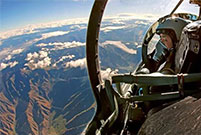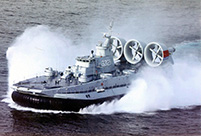

The US Navy is set to unleash an army of 'ghost boats' to scour the coasts for enemy submarines.
They hope to end the growing threat of quiet, diesel powered enemy submarines entering American waters undetected.
Bosses revealed the first 132 foot long ship, officially named 'The Anti-Submarine Warfare Continuous Trail Unmanned Vessel' will take to the water on April 7th.
The first 132 foot long ship, officially named 'The Anti-Submarine Warfare Continuous Trail Unmanned Vessel' will take to the water on April 7th. It could be used for counter-mine missions, reconnaissance and resupply.
Darpa director Dr. Arati Prabhakar and deputy director Dr. Steve Walker revealed the craft.
'Imagine an unmanned surface vessel following all the laws of the sea on its own,' Walker told media, 'and operating with manned surface and unmanned underwater vehicles.'
The robot boats will go to sea for us to three months at a time.
It will be christened in April in Portland, Oregon, and then begin to demonstrate its long-range capabilities over 18 months in cooperation with the Office of Naval Research and the Space and Naval Systems Warfare Command.
'We think the real cost savings will be in operating this vessel at sea compared to how we operate vessels today,' he added.
'It could be used for counter-mine missions, reconnaissance and resupply.'
The project began in 2010, when the Defense Advanced Research Projects Agency, or DARPA, announced that they were building a 132-foot autonomous boat to track quiet, diesel-powered submarines.
The program was dubbed Anti-submarine Warfare Continuous Trail Unmanned Vessel, or ACTUV.
In six weeks of tests along a 35-nautical mile stretch of water off of Mississippi earlier this year, testers at engineering company Leidos and Darpa put the ACTUV's systems through 100 different scenarios.
The test boat was able to tail a target boat at 1 kilometer's distance, something military bosses say is a major step forward.
'Picking up the quiet hum of a battery-powered, diesel-electric submarine in busy coastal waters is 'like trying to identify the sound of a single car engine in the din of a major city,' says Rear Admiral Frank Drennan, commander of the Naval Mine and Anti-Submarine Warfare Command.
Speaking at a National Defense Association Event in Virginia last year, Darpa program manager Ellison Urban outlined why the Navy needs sub-hunting boat bots.
 |
 Have you ever taken these beautiful subways in China?
Have you ever taken these beautiful subways in China? Chinese beauties, foreign models meet in Chengdu
Chinese beauties, foreign models meet in Chengdu Awesome! Aerial pictures taken on J-11 fighter
Awesome! Aerial pictures taken on J-11 fighter A foreign girl explains what China should be proud of
A foreign girl explains what China should be proud of Chinese navy's air-cushioned landing craft in pictures
Chinese navy's air-cushioned landing craft in pictures Chinese pole dancing master opens class in Tianjin
Chinese pole dancing master opens class in Tianjin Splendid Sichuan after snow
Splendid Sichuan after snow College girl of Vancouver crowned Miss Chinese Int'l 2016
College girl of Vancouver crowned Miss Chinese Int'l 2016 Pentagonal Mart becomes the largest vacant building in Shanghai
Pentagonal Mart becomes the largest vacant building in Shanghai Top 20 hottest women in the world in 2014
Top 20 hottest women in the world in 2014 Top 10 hardest languages to learn
Top 10 hardest languages to learn 10 Chinese female stars with most beautiful faces
10 Chinese female stars with most beautiful faces China’s Top 10 Unique Bridges, Highways and Roads
China’s Top 10 Unique Bridges, Highways and Roads After spate of espionage allegations, US law firm opens first China office
After spate of espionage allegations, US law firm opens first China office Author Feng Tang attacks decision to pull book from shelves
Author Feng Tang attacks decision to pull book from shelves Going ape for New Year
Going ape for New Year Black lungs
Black lungsDay|Week